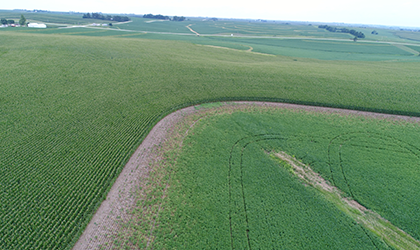
Gall midge larvae damage to soybean at the edge of a field. Credit: Megan Bierbaum.
In previous years, the gall midge has been observed in South Dakota soybean fields. We originally didn’t think that the gall midges had much of an impact on plant health. However, as noted earlier this year, it is starting to look like gall midges are actually having negative impacts on soybean growth and development. We are asking that if you have soybean that are affected by gall midges, please contact us at SDSU Extension so that we can visit the field. We will be working diligently to figure out a best approach for either prevention or management of this pest. For fields that we might visit, we would like to obtain samples of the gall midge larvae from live plants to further study them.
Like their name suggests, gall midges form galls (i.e., abnormal swelling) in infested plants. For soybean, these swollen areas appear near the soil surface. The stem will look woody and will snap like a twig if pressure is applied. So far, these cases seem to be more prevalent in areas where soybean have been grown for at least two consecutive years. However, there are also many cases of gall midge larvae infestation that only affect the border of a field. This suggests that the flies are emerging from previous residue and moving into the new crop. There are also cases where this edge effect is being observed near CRP or pastures.
At this point in time, we are not recommending late season foliar sprays for this pest. Gall midge larvae are generally found at the base of the plant underneath the epidermis. This makes it very difficult to get foliar sprays to come into contact with the larvae. Furthermore, the gall midges in soybean seem to be restricting water and nutrient flow through the stem, which removes the potential effects that a systemic foliar insecticide might otherwise have.
The first step in figuring out a management approach will be identifying the pest to species so that we might better understand when and how it is infesting soybean.






Post a comment
Report Abusive Comment